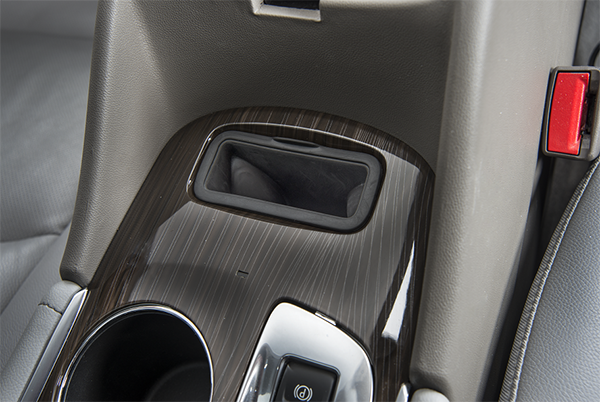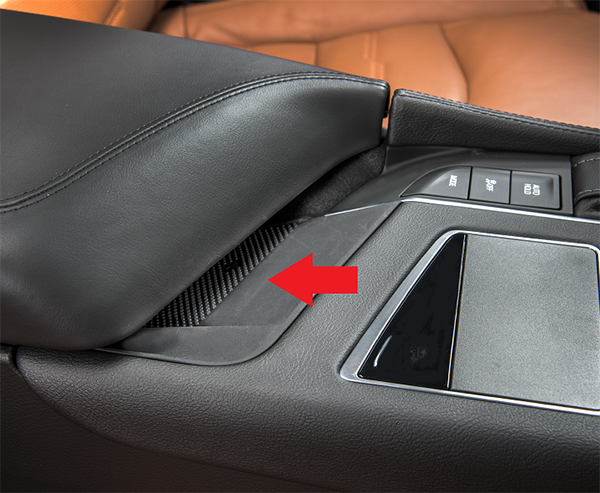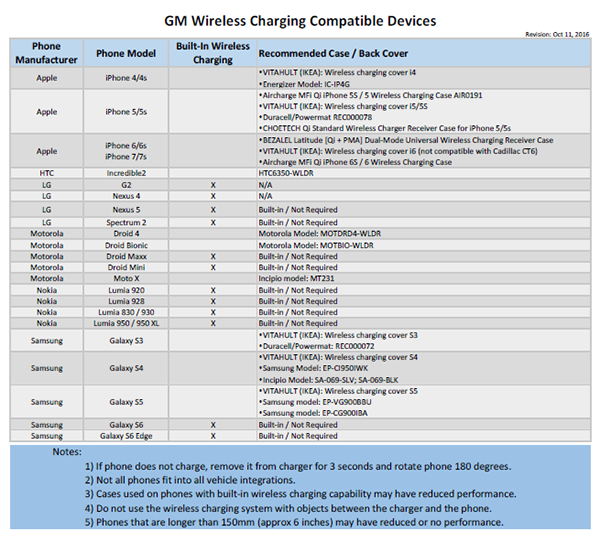2015 - 2017 Cadillac ATS-V and CTS-V: GM TechLink: Wireless Charging Device Compatibility and Testing
Estimated Reading Time: 4 MinutesGM TechLink
September 28, 2016
Wireless charging of mobile devices has become a popular option on a number of 2015 and newer GM passenger cars and light-duty trucks. It’s a convenient way for drivers to charge a smartphone without the need for a charging cord.
GM models that may have an optional wireless charging system include 2015-2017 ATS, ATS-V, CTS, CTS-V, Escalade, Tahoe, Suburban, Yukon; 2016-2017 CT6, XTS, Camaro, Cruze, Impala, Malibu, Volt, Silverado, Sierra; and 2017 LaCrosse, XT5, Colorado, and Canyon.
The charging system typically features a charging pad or pocket located on the center console. Here are some examples of charging systems on the Camaro (Fig. 1), Malibu (Fig. 2), CT6 (Fig. 3) and Sierra. (Fig. 4)

Fig. 1

Fig. 2

Fig. 3

Fig. 4
The wireless charging process requires customers to have a compatible phone or a compatible case equipped with an inductive coil. Wireless inductive charging uses an electrically induced magnetic field to transfer energy from the coil in the vehicle’s charging module to the coil in the phone or its case.
Compatible Devices
An increasing number of smartphones have built-in wireless charging technology. Some smartphones require a wireless-capable back cover or adapter. Customers should contact their phone retailer for information about a wireless charging adapter/cover if it’s required for their phone.
The GM Wireless Charging Compatible Devices chart (Fig. 5) has been recently updated. It provides an easy reference of compatible smartphones that feature built-in wireless charging or offer a wireless charging case.

Fig. 5
Charging a Device
1. Verify the phone is properly equipped for wireless charging.
2. Turn on the vehicle or use Retained Accessory Power.
3. Remove all objects from the charging pocket or pad before attempting to charge the phone. Make sure there are not any coins, keys, cards, etc., trapped between the phone and the charging surface.
4. On a charging pad, align the back of the phone (screen facing up) against the flat surface of the charging pad. For a charging pocket, insert the phone (screen facing rearward) into the pocket so the phone screen faces the rubber bumps within the pocket. Proper positioning is critical; the charging coils of the charging surface and the device must line up in order for charging to take place.
5. When the phone is properly aligned, the phone charging icon (lightning bolt) will appear on the infotainment screen and, a few seconds later, the phone’s battery will start charging. If the phone does not charge, remove it from the pocket/pad, rotate it 180 degrees, wait for 3 seconds, and reposition it correctly.
TIP: The Colorado and Canyon do not display the phone charging icon on the infotainment screen. An LED indicator on the console is green when the phone is charging. If the LED is yellow, the phone is not charging and it should be repositioned correctly on the charging pad.
Not all phones will fit properly in all charger integrations. Phones that are longer than 150mm (approximately 6 inches) may have reduced performance or may not charge.
In addition, protective cases used on phones with built-in wireless charging capability may have reduced charging performance.
For vehicles with charging pads, rough roads and vehicle dynamics may result in the phone shifting out of position and charging to stop. If this happens, lift the phone for 3 seconds and place again on the pad with the correct alignment to re-establish charging.
If customers have any questions about wireless charging, direct them to the Owner Center websites for their respective brand.
Testing using the EL-51755 Test Tool
The EL-51755 Inductive Charging Test Tool can be used to verify charging system operation in a vehicle. There is no need to remove the rubber sleeve from the pocket or pad for testing.
When using the test tool with a charging pocket, position the edge of the tool (where the lanyard is attached) approximately 1/4-inch below the lip of the rubber sleeve surrounding the pocket. Keep the tool centered against the front wall to align the coil in the test tool with the coil in the vehicle module.
On a charging pad, align the tool against the alignment rib. For both the pad and pocket, ensure that the flat side (non-LED side) of the tool aligns against the flat charging surface.
To verify the operation of the charging system, simply position the tool on the charging pad or in the charging pocket. If the tool’s wireless charging indicator is on, the charging system is operating properly and any charging concern may be caused by an incompatible or defective mobile device. If the charging indicator is off, continue diagnosis using the appropriate Service Information.
To complete the test successfully, the procedure may need to be repeated 5 times. Between each attempt, remove the tool and wait at least 3 seconds
TIP: For any Mobile Device Wireless Charging System concerns, refer to circuit/system verification and testing in the appropriate Service Information. A scan tool cannot be used since the system is not connected to any control module. No DTCs or data parameters are available.
– Thanks to Deepali Patel, Dan Lascu, Chinmaya Sindgikar, Gurpreet Behniwal, and Manju Bhat